Any blogger, marketer, or business owner who’s had some level of success online will tell you that keyword research is the foundation of any good content strategy.
Gone are the days when you could write about what you wanted while blogging. With the level of competition out there today, it’s crucial to focus on writing for the user so you can answer their queries.
If you can do this effectively, search engine algorithms will reward your content with higher rankings.
The good news is, there are tools and data to help you achieve this.
But before we get to that, let’s cover the basics to ensure that we’re all on the same page about why is keyword research important for SEO and what is it.
What is Keyword Research?
Keyword research is the practice of finding and analyzing popular search terms that users enter into Google and other search engines when they are looking for information, products, or services. You can then include these terms strategically in your content strategy.
It’s important to note that keyword research is driven by data, and proper keyword research provides data so that your content strategy isn’t aimless and you have a direction to focus on for what you need to accomplish.
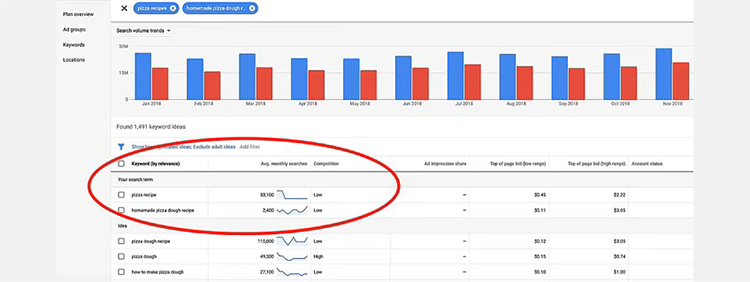
With the right keyword research tools, you’ll not only understand the language your target customers are using when they search for products and services related to yours, but you’ll also be able to know exactly what it will take to actually rank for your target keywords.
Why is Keyword Research Important for SEO That Much?
Keyword research is important for a number of reasons:
- Direction: As previously stated, proper keyword research will guide you in the direction to take with your content.
- No Need to “Guess” on Topics: Your keyword research will reveal the topics you should be focused on in order to create content that’s relevant to your target readers.
- Focus on the “Right” Topics: You’ll know what to write about to get real results, and not just things that bring vanity metrics like traffic.
- Topical Authority: When you can rank for the right keywords, you’ll find it easier to build authority in your space.
- Develop a Clear Content Strategy: Your keyword research will reveal the easiest and most effective way to inform your content strategy (as you’ll find out below).
- Fastest Path to Profitability: If you can target the right keywords, you’ll fast-track your way to profitability.
- Traffic Growth: The first page of Google gets at least 71% of all web traffic whereas the second page only gets about 6%, showing just how important it is to rank on Google’s first page.
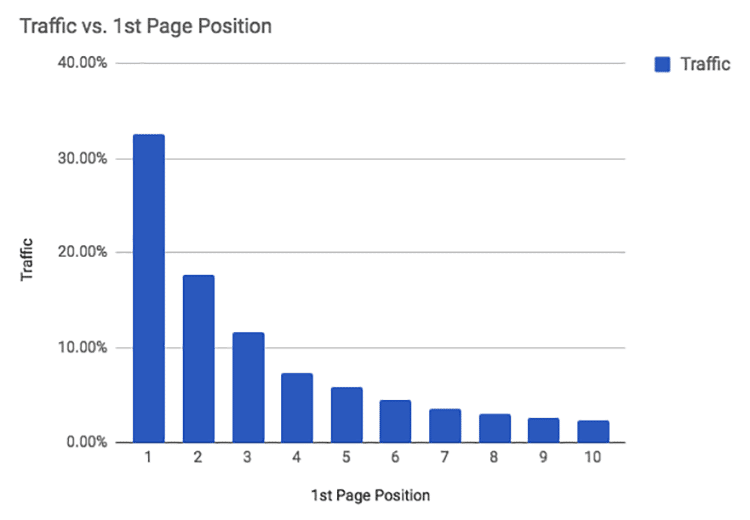
Length of Keywords is Important
Keywords or phrases can be grouped into 3 main categories according to their length:
Short Tail Keywords
These are general keywords, for example, “shoes”, “insurance”, or “winter jacket”, typically between one and two words in length.
They have the highest search volume, as well as the most competition. Volume is measured by monthly search volume (MSV) which simply means the number of times users across all audiences searched for the keyword each month.
But, since the keywords are not targeted, their conversion rates are the lowest.
These types of keywords are extremely hard to rank for, particularly for those who are just getting started.
That’s because you’ll be competing against large, well-established brands, so it’s often better to skip these keywords when doing your keyword research.
Middle Tail Keywords
These are more specific keywords, for example, “shoes for men”, “car insurance quotes”, or “winter jacket”.
They are typically between three and four words in length with moderate search volume and an average level of competition. Since these keywords are a bit more targeted to the searcher than short-tail keywords, their conversion rates are a little higher.
You should focus on middle tail keywords during your keyword research, and you’ll likely find a lot of three to four-word search terms that are untapped in your market. With luck, you’ll be able to easily rank for these on the first page of Google for your business.
Long-Tail Keywords
These are very specific keywords, such as “black winter jacket for women”. They usually contain five or more words and have the lowest search volume and least competition.
But, the conversion rates for these types of keywords are typically very high since they are extremely focused on the searcher.
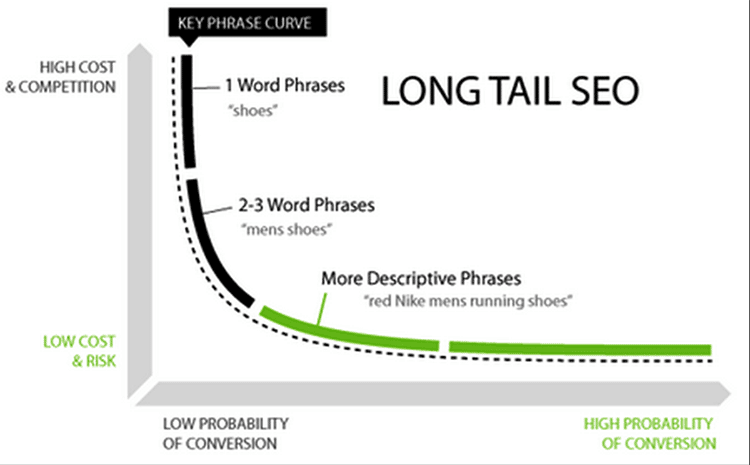
Long-tails are the best keywords to focus on when conducting keyword research for your website. They will help you grow your website traffic and they are also good for bringing in targeted sales.
The best part about using long tail keywords is that there are tons of highly valuable keywords just waiting for you to discover and optimize for.
So, which keywords are best?
The keywords you choose for your content marketing will depend on the type of traffic you want to drive to your website or blog. In essence, the longer the keywords, the lower the search volume.
But, there are other metrics besides the number of monthly searches that make longtail keywords quite valuable.
For instance, the conversion rates tend to be higher for long-tail keywords than they are for their short-tail counterparts.
Also, when considering the issue of volume, keep in mind that there’s no point in ranking on the first page for a specific keyword if it never gets any searches. So, choose keywords with a healthy search volume so your hard work can result in targeted traffic to your site.
The bottom line is that long tail keywords are almost always less competitive because they are searched less often, which is why it’s a great idea to focus mainly on these as part of your content strategy to help you rank faster and grow your blog.
Understanding Keyword Search Intent
If you want to choose the absolute best keywords for your strategy, it’s important to think about the user’s intentions behind each search.
In order to do this effectively, you align your keywords with the buyer’s journey, which is as follows:
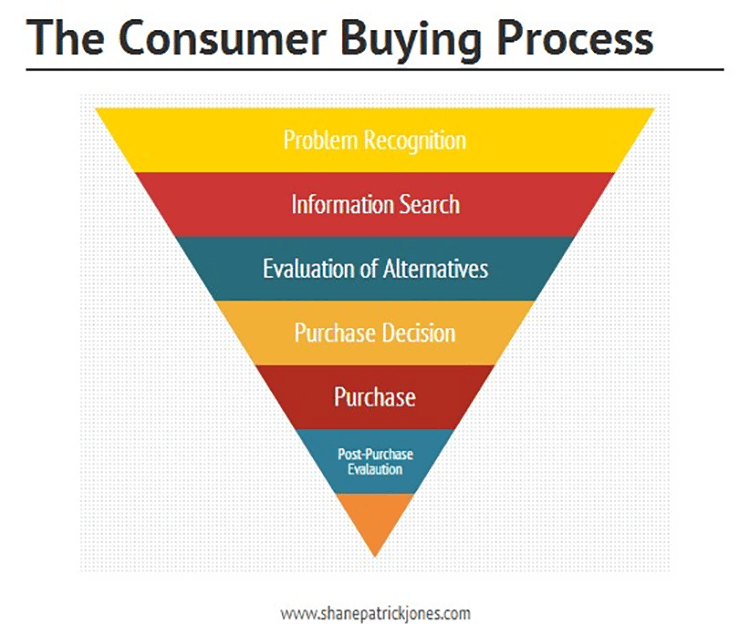
Although it’s illustrated in the image below as a 6-step process, at its core, the buyer’s journey really a three-step process:
- Step #1: Awareness Stage: This is where the buyer realizes that they have a problem.
- Step #2: Consideration Stage: Here, the buyer has clearly defined the problem and searches for solutions to the problem.
- Step #3: Decision Stage: By the time the buyer gets here, he has a solution in mind chosen from the available options.
In order for your website to not only rank high fast but also be able to drive targeted sales, you want to be able to choose keywords that meet every stage of your buyer’s journey.
This way, you’ll be able to drive traffic to your site regardless of where the visitor is on their path to becoming a paying customer.
There are 3 types of keywords that will help you achieve this:
1. Informational Keywords: These are the types of keywords searchers use when looking for more information about something. Examples of informational keywords include phrases that begin with words like “how”, “what”, “why”, etc.
For instance, “How to make money online”, or “What is the best movie streaming site?”
2. Transactional Keywords: Transactional keywords are those that indicate a specific desire to take some type of action, such as making a purchase on a site. Examples of transactional keywords include words like
- Buy
- Purchase
- Discount
- Deal
- Cheapest
- For sale
- Coupon
- Where to buy, etc.
For instance, “Where to buy N95 masks”, or “Hotel deals in Mexico”.
3. Navigational Keywords: These types of keywords are those typed by searchers with the intent of navigating to a specific page as opposed to transacting or looking for information.
Examples of navigational keywords often include brand names, product/service names, or locations, as well as words like “near me”, “directions”, etc.
For example, “Thai restaurants near me”, or “One Hour Professor online course”.
When you understand keyword search intent, it makes it a lot easier for you to create content that is optimized for visitors at the top, middle, and bottom of your sales funnel.
In addition to relevance or search intent, there are a couple of other elements of keyword research that you should keep in mind while you go through the process outlined below:
Keyword research alone won’t make you successful. There are other factors to consider, such as authority.
Google provides more weight to any sources that it deems to be authoritative. So, do your best to become an authority in your space by infusing your website with helpful, actionable information.
You’ll need to promote your content to earn backlinks and social signals, and in time you will be seen as being authoritative in that niche.
How to Complete Keyword Research
Now, it’s time to complete your keyword research so you can narrow down lucrative search terms for your site.
Step #1: Get a Keyword Research Tool
The first thing you need is a keyword research tool that will make it easy for you to gather and analyze important data.
There are a lot of tools to choose from, including:
- Google Keyword Planner
- Ubersuggest
- Keysearch
- Ahrefs
- SEMRush
- KWFinder by Mangools
Any of these tools will serve you well. You can pick one of the free ones or sign up for a free trial to get started.
Log in to your keyword research tool and start searching for keyword ideas for short tail and middle tail keywords.
* Note: You should already have a list of all the important and relevant keywords and topics in your niche or industry. If not, do a quick brainstorming process to come up with a list of keywords based on what you know about your business.
As you go about your searches, you’ll be provided with suggestions for longtail keyword ideas. Keep in mind that short tail keywords are extremely difficult to target, so you need to focus more on middle and longtail options.
Make a list of the words and phrases that have a healthy amount of traffic (e.g. 100 searches per month for middle tail and 10 searches per month for long tail keywords).
Step #2: Analyze the Competition
Depending on whether or not you are using a paid tool, you’ll be able to view the data to help you analyze your competition for specific keywords and phrases.
You’ll see a competition score or keyword difficulty (KD) next to the keyword. The figure ranges between 0 and 100 to give you an idea of how difficult or easy it will be to target that particular keyword.
You want to choose keywords with low competition because if the competition is too high, you’ll have to work very hard to rank new content for it.
At this time, you’re better off going for the easy wins first. So make your choices according to the advice of your keyword research tool on which keywords have the lowest competition scores while keeping in mind that the longer keyword phrases tend to have less competition than shorter ones.
Step #3: Choose the Best Keywords to Target
Once you’re done analyzing your competition, create a list of all the keywords you want to focus on.
Don’t overthink it. There’s no right or wrong here, only your choices of the keywords you intend to target.
Step #4: Group Related Keywords Together
As you continue with your keyword research, the tool will offer suggestions for additional, related keywords. It’s important to note these because you don’t want to target a lot of keywords that are too closely related.
Instead, you can create keyword “clusters” so you don’t have to write new pieces of content for each variation of a keyword.
For example, if you wanted to write an article about “How to do keyword research”, you might get the following keyword suggestions:
- How to do keyword research
- How to do keyword research for SEO
- How to do keyword research SEO
- How to do SEO keyword research
- How to research for SEO
As you can see, all of them are closely related, so it would be a good idea to simply pick one of the keywords and write content that’s focused on that keyword. You can then include the other keywords on that same page.
This will help you avoid creating duplicate content on your site. You’ll also prevent keyword cannibalization, something that (Google frowns upon), which is when multiple pages on your website compete for the same group of keywords.
As a general rule, try to focus on just two to three keywords on each page.
Step #5: Choose the Best Content Format
With your list of keywords in hand, your next step is to determine the proper content format for each group of keywords.
A simple way to do this is by searching for some of your keywords on Google and making a note of the type of content ranked at the top for those search terms.
This will tell you whether you need to create list posts, infographics, videos, images, tables, graphs, or simple text posts for those keywords.
For example, if you conduct a search for “How to change Google background”, the first five results are videos.
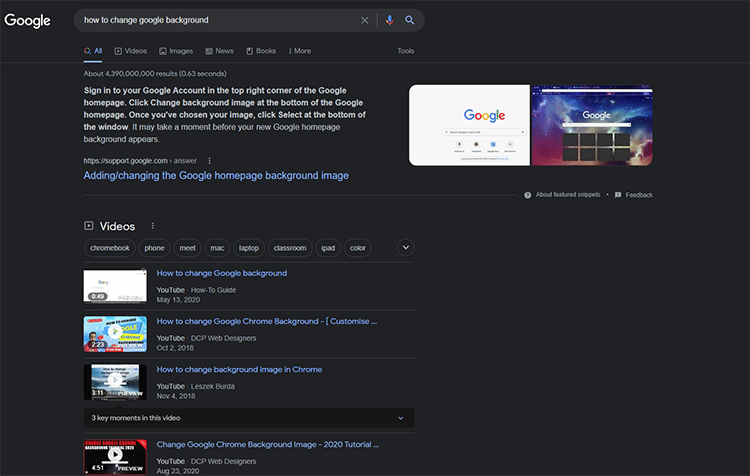
But, a search for “How to start a blog” reveals mostly list posts with a step-by-step process for starting a blog.
Google provides you with the answer to which format is best for each of your keywords. All you have to do is conduct the search and take a look at the top results.
When you can match your keywords to the right content format, you’ll be able to rank your content a lot easier and faster.
You should incorporate all the best content practices that are in use when you start writing your content. The priority and effectiveness of these practices can change based on what Google is doing but SEO optimization will always be an integral part of creating content.
Want to learn more?
Join My Keyword Research Course!
This is an in-depth course I created aimed at helping you learn how to conduct keyword research the right way.
Simply sign up, and I’ll walk you through everything clearly so that by the end of it, you’ll know the exact process for picking lucrative keywords that will help you drive more traffic and sales to your website.
- Marketing Trend Insights: Get insights into current marketing trends so you can focus your content around relevant keywords and topics that your audience is searching for.
- Traffic Growth: Identify the best-fitting keywords for your content so you can rank higher and faster in search engine results and drive more targeted traffic to your website.
- Lead Generation: Target visitors and guide them through your buyer’s journey from the awareness stage to the actual purchase by tackling the questions they want answers to.
Sign up for the keyword research course here.
Final Thoughts
I hope this guide on why is keyword research important for SEO has helped you understand the importance of keyword research for blogging and SEO.
It’s crucial for building a successful strategy with your blog, and unless you use keyword research as the foundation for your content strategy, you’ll be fighting an uphill battle to rank your content on Google.
But, with the step-by-step process for keyword research outlined in this article (and explained in more detail in my course), you’ll be able to get valuable insights into the queries that your target audience searches on Google.
Armed with this insight, you can inform your content strategy and your larger online marketing strategy to supercharge your content marketing results, outpace your competitors, and grow your revenue.
